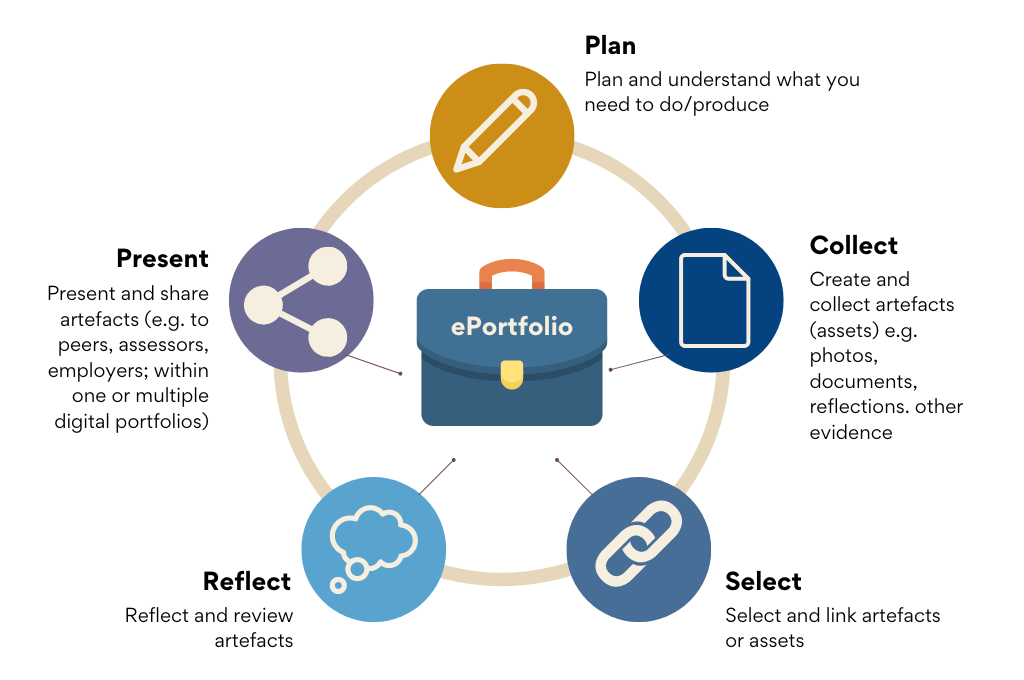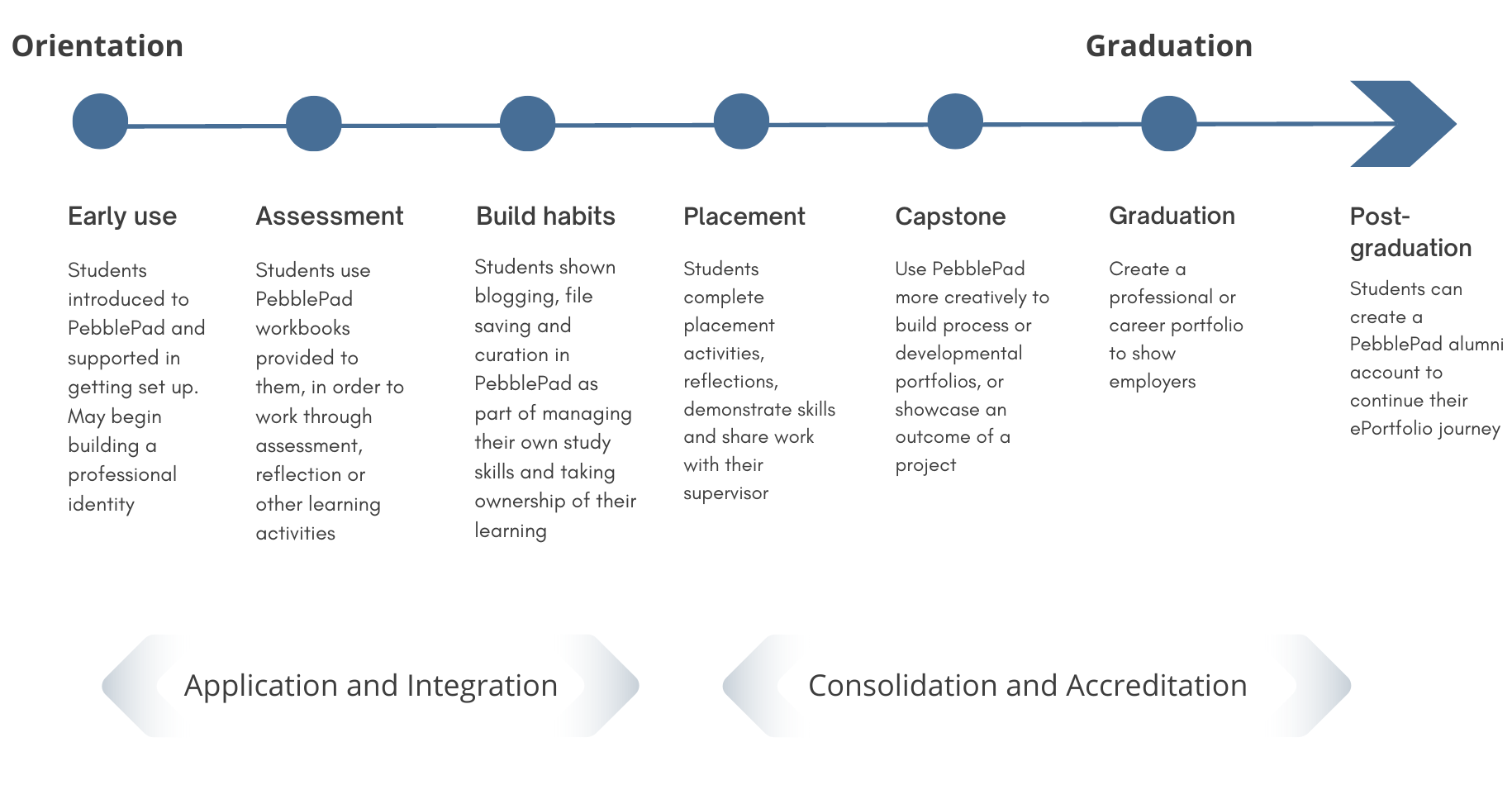ePortfolios
ePortfolios offer students a space to create and curate evidence and artefacts. Purposeful reflection associated with portfolio creation engages students in metacognition.
What is an ePortfolio?
The term ePortfolio is a digital portfolio of work presented in a website-like format, which demonstrates learning or skills. PebblePad is the University-supported ePortfolio platform, which gives students a personal learning space to create, curate and store files, media, and artefacts.
In this space, students can purposefully reflect on their learning and/or progress based on different digital items, artefacts or evidence, and present these with particular contexts and audiences in mind (Coleman, 2017; Sutherland and Powell, 2007). An ePortfolio typically engages students in a cycle of collecting or creating, reflecting, selecting and/or curating, and presenting and sharing. To make the most out of the ePortfolio approach, it is best to implement it at a course level, and not just in a standalone subject.

Why are ePortfolios useful?
Benefits for students
- Develop skills in critical thinking and reflective practice through purposeful reflection on goals, skills and evidence of learning
- Promotes development of professional identity through collection and curation of evidence of professional practice
- Showcases students’ creativity by giving flexibility to express their personality through different media
- Demonstrates expertise and achievement of outcomes (Bozarth, 2014)
- Promotes students’ agency and ownership of learning, including self-regulation and metacognition (Clarke & Boud, 2016)
- Engages students in deep learning (Watson, Kuh, Rhodes, Light & Chen, 2016)
- Connects formal and informal learning experiences, including across and outside of the curriculum (Yancey, 1998).
Benefits for educators
- Adds industry-related skills to the curriculum
- Supports choice, flexibility and multimodality in assessment
- Provides opportunities for formative feedback
- Streamlines assessment administration by removing paper-based portfolio assessment processes
- Builds your relationship with students including while on placement or in the field.
How to implement ePortfolios
If you’re considering using ePortfolios in your course, these steps will help you get started.
-
Decide if an ePortfolio is right for you and confirm the ePortfolio approach
First, it’s important to confirm that an ePortfolio suits your needs and decide on your approach. ePortfolios are most effective when integrated and embedded across a course, and used developmentally and longitudinally over time (Eynon & Gambino, 2017). ePortfolios also work well when students are supported in regular reflection through a dedicated process.
Ask yourself these questions before choosing an ePortfolio approach:
- What is the purpose of the ePortfolio? What does this look like across the subject/and across the course?
- What should students be able to do with their portfolio work short-term and long-term?
- What activities need to be supported? How structured or flexible (teacher-directed vs student-centred) do these need to be?
- What reflection and portfolio processes do you need to encourage? Are these relevant to and indicative of what students will do in their professional lives following graduation? Is there a model or framework for reflection that might be relevant for students to use?
- What will assessment, feedback and reporting look like? Do you (or other supervisors) need to track students (eg while on placement) or support formative or progressive assessment and feedback?
-
Build and support ePortfolio activities
Consider the ways in which you can build reflection and ePortfolio thinking into your activities and assessment. For example:
- Develop activities that provide students with explicit opportunities to undertake each part of the ePortfolio process, as well as to revisit past reflections/activities in later stages in order to progress their learning.
- Provide students with a reflection framework so they have strategies for how to reflect deeply
- Provide opportunities for students to collect and reflect, such as:
- Encourage students to keep their own blog during the subject/course
- Remind students to upload all relevant work to their ePortfolio repository that demonstrates their professional skills, including finalised essays and other assignments.
- Provide examples of good ePortfolios, or model ePortfolio practice by keeping your own professional portfolio and sharing it with your students.
-
Integrating across a course/program
ePortfolios are most effective and beneficial when integrated and embedded across a course, and when used developmentally and longitudinally over time (Eynon & Gambino, 2017). Students will benefit more if they are engaged with ePortfolio activities at multiple key points through the learning journey. To make ePortfolio meaningful to students, it is also important to provide appropriate training and support with both ePortfolio practices and how to use the technology/platform.
We recommend a course-level approach to ePortfolios where possible, so students and staff to gain the most benefit.
For an example of what this might look like as a course learning journey using PebblePad, review the PebblePad across the course: A learning journey diagram below. Not all points in the journey need to be developed, but we recommend including or encouraging ePortfolios at a few key points through the course.

What learning technologies support ePortfolios?
PebblePad is the University’s dedicated ePortfolio platform. Students and staff can create portfolios, blogs, reflections and other items relevant to ePortfolio practice, and to collect evidence for and track and report on professional standards. PebblePad also has dedicated options for collecting and archiving portfolio work for assessment. Refer to the PebblePad home page and PebblePad supported learning and assessment activities guide for further information on PebblePad and what are suitable formats and assessment/activity types for PebblePad.
Other tool options include:
- Cadmus is an online assessment environment that can support journal and reflection activities and progressive assessment.
- Canvas’ Groups and ePortfolio tools can be used to support blog-style activities if PebblePad is unavailable (eg for external users) or not the recommended choice.
- Microsoft OneNote, while primarily a note-taking application, would allow students to collect reflections and evidence related to various topics as a way to track and present their development across the course in a format similar to an ePortfolio. OneNote can be an easy way for students to collect evidence and build relevant skills.
- Other Microsoft, Google and Adobe products that are supported by the University could be used to build ‘ePortfolio-like’ multimedia websites or presentations. Such tools include Microsoft PowerPoint, Google sites, Microsoft Sway, Adobe Express and Adobe Portfolio.
ePortfolios in action
In the Bachelor of Commerce Internship subject, students use peer review, combined with regular reflections using an ePortfolio tool, for engagement, feedback, and a way to build self-efficacy while on internship. For the full case study, see: peer review: maximising engagement and feedback literacy.
In the Melbourne Graduate School of Education, students in both the Master of Teaching and the Graduate Diploma of Early Childhood Education have used ePortfolios to reflect on how they have changed and grown through their studies. See our exemplary student ePortfolios for details and examples.
Resources
- Learning Environments, University of Melbourne. PebblePad supported learning and assessment activities
- Learning Environments, University of Melbourne. PebblePad
- PebblePad. PebblePad Workbooks vs. Portfolios
- ePortfolio examples and templates Padlet – this Padlet contains links to a range of ePortfolio examples, organised by discipline.
- Learning Environments, University of Melbourne. Reflective practice
- Learning Environments, University of Melbourne. Designing reflection activities
- Learning Environments, University of Melbourne. Reflection and consolidation activities for BSL sessions
References
- AAC&U (American Association of Colleges & Universities). (n.d.). ePortfolios. https://www.aacu.org/trending-topics/eportfolios
- Bozarth, J. (2014). Show Your Work: The payoff and how-to's of working out loud. San Francisco, CA: Wiley.
- Clarke, J. L., & Boud, D. (2016). Refocusing portfolio assessment: curating for feedback and portrayal. Innovations in Education and Teaching International. https://doi.org/10.1080/14703297.2016.1250664
- Coleman, K. (2017). Down the rabbit hole: Lessons learned curating, presenting and submitting a digital research portfolio as PhD thesis. ePortfolios Australia Forum, 20–21 September, 2017. https://eportfoliosaustralia.files.wordpress.com/2017/09/ebook_eportfolioforum_2017_papers_v1_20170907.pdf
- Eynon, B., & Gambino, L. (2017). High-impact ePortfolio Practice. Stylus Publishing.
- Hartnell-Young, E., Harrison, C., Crook, C., Pemberton, R., Joyes, G., Fisher, T., & Davies, L. (2007). The Impact of ePortfolios on Learning. British Educational Communications and Technology Agency (BECTA). University of Nottingham, Corp Creators. https://dera.ioe.ac.uk/id/eprint/1468/
- Khoo Mei Sui, L., Maor, D., & Schibeci, R. (2011). The Engineering Eportfolio: Enhancing Communication, Critical Thinking and Problem Solving and Teamwork Skills? World Academy of Science, Engineering and Technology, 77.
- Learning Environments, University of Melbourne. (2022). Reflection and consolidation activities for BSL sessions. https://le.unimelb.edu.au/learning-teaching-assessment/dual-delivery-and-bsl/bsl-sessions/designing-bsl-sessions/reflection-and-consolidation-activities
- Learning Environments, University of Melbourne. (2022). Designing reflection activities. https://le.unimelb.edu.au/news/articles/designing-reflection-activities
- Mazlan, K., Khoo Mei Sui, L., & Jano, Z. (2015). Designing an Eportfolio Conceptual Framework to Enhance Written Communication Skills among Undergraduate Students. Asian Social Science, 11. https://doi.org/10.5539/ass.v11n17p35
- Sutherland, S. (2019). Some thoughts about ePortfolios. https://www.linkedin.com/pulse/some-thoughts-eportfolios-shane-sutherland/
- Sutherland, S. (2021). Are your ePortfolios DAPPER? https://www.linkedin.com/pulse/your-eportfolios-dapper-shane-sutherland/?trk=public_profile_article_view
- Sutherland, S., & Powell, (2007). CETIS SIG Mailing List Discussions. https://www.jiscmail.ac.uk/cgi-bin/webadmin?A1=ind0707&L=CETIS-PORTFOLIO#3
- Watson, C. E., Kuh, G. D., Rhodes, T., Light, T. P., & Chen, H. L. (2016). Editorial: ePortfolios – The Eleventh High Impact Practice. http://www.theijep.com/pdf/IJEP254.pdf
- Yancey, K.B. (1998). Reflection in the Writing Classroom. Logan, UT: Utah State University Press.
This page was last updated on 11 Apr 2024.
Please report any errors on this page to our website maintainers